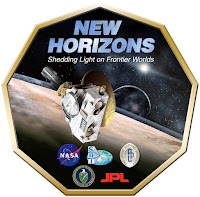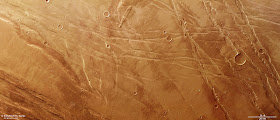NASA - New Horizons Mission logo.
July 11, 2015
Image caption: New Horizons' last look at Pluto's Charon-facing hemisphere reveals intriguing geologic details that are of keen interest to mission scientists. This image, taken early the morning of July 11, 2015, shows newly-resolved linear features above the equatorial region that intersect, suggestive of polygonal shapes. This image was captured when the spacecraft was 2.5 million miles (4 million kilometers) from Pluto.
Three billion miles from Earth and just two and a half million miles from Pluto, NASA’s New Horizons spacecraft has taken its best image of four dark spots that continue to captivate.
The spots appear on the side of Pluto that always faces its largest moon, Charon—the face that will be invisible to New Horizons when the spacecraft makes its close flyby the morning of July 14. New Horizons principal investigator Alan Stern of the Southwest Research Institute, Boulder, Colorado, describes this image as “the last, best look that anyone will have of Pluto’s far side for decades to come.”
The spots are connected to a dark belt that circles Pluto’s equatorial region. What continues to pique the interest of scientists is their similar size and even spacing. “It’s weird that they’re spaced so regularly,” says New Horizons program scientist Curt Niebur at NASA Headquarters in Washington. Jeff Moore of NASA’s Ames Research Center, Mountain View, California, is equally intrigued. “We can’t tell whether they’re plateaus or plains, or whether they’re brightness variations on a completely smooth surface.”
The large dark areas are now estimated to be 300 miles (480 kilometers) across, an area roughly the size of the state of Missouri. In comparison with earlier images, we now see that the dark areas are more complex than they initially appeared, while the boundaries between the dark and bright terrains are irregular and sharply defined.
In addition to solving the mystery of the spots, the New Horizons Geology, Geophysics and Imaging team is interested in identifying other surface features such as impact craters, formed when smaller objects struck the dwarf planet. Moore notes, “When we combine images like this of the far side with composition and color data the spacecraft has already acquired but not yet sent to Earth, we expect to be able to read the history of this face of Pluto.”
When New Horizons makes its closest approach to Pluto in just three days, it will focus on the opposing or “encounter hemisphere” of the dwarf planet. On the morning of July 14, New Horizons will pass about 7,800 miles (12,500 kilometers) from the face with a large heart-shaped feature that’s captured the imagination of people around the world.
New Image of Pluto: 'Houston, We Have Geology'
Image above: An annotated version indicates features described in the text, and includes a reference globe showing Pluto’s orientation in the image, with the equator and central meridian in bold.
It began as a point of light. Then, it evolved into a fuzzy orb. Now – in its latest portrait from NASA’s New Horizons spacecraft – Pluto is being revealed as an intriguing new world with distinct surface features, including an immense dark band known as the “whale.”
As the newest black and white image from New Horizons’ Long Range Reconnaissance Imager (LORRI) appeared on the morning of July 10, members of the science team reacted with joy and delight, seeing Pluto as never before. There will no doubt be many similar moments to come. New images and data are being gathered each day as New Horizons speeds closer to a July 14 flyby of Pluto, following a journey of three billion miles.
Image above: Science team members react to the latest image of Pluto at the Johns Hopkins University Applied Physics Lab on July 10, 2015. Left to right: Cathy Olkin, Jason Cook, Alan Stern, Will Grundy, Casey Lisse, and Carly Howett.
“We’re close enough now that we’re just starting to see Pluto’s geology,” said New Horizons program scientist Curt Niebur, NASA Headquarters in Washington, who’s keenly interested in the gray area just above the whale’s “tail” feature. “It’s a unique transition region with a lot of dynamic processes interacting, which makes it of particular scientific interest.”
New Horizons’ latest image of Pluto was taken on July 9, 2015 from 3.3 million miles (5.4 million kilometers) away, with a resolution of 17 miles (27 kilometers) per pixel. At this range, Pluto is beginning to reveal the first signs of discrete geologic features. This image views the side of Pluto that always faces its largest moon, Charon, and includes the so-called “tail” of the dark whale-shaped feature along its equator. (The immense, bright feature shaped like a heart had rotated from view when this image was captured.)
“Among the structures tentatively identified in this new image are what appear to be polygonal features; a complex band of terrain stretching east-northeast across the planet, approximately 1,000 miles long; and a complex region where bright terrains meet the dark terrains of the whale,” said New Horizons principal investigator Alan Stern. “After nine and a half years in flight, Pluto is well worth the wait.”
Pluto By Moonlight
It’s Antarctic winter on Pluto. The sun has not been visible for twenty years in this frigid south polar region; it will not shine again for another 80 years. The only source of natural light is starlight and moonlight from Pluto’s largest moon, Charon.
On July 14, New Horizons mission scientists will soon obtain the first images of the night region of Pluto, using only the light from Charon, itself softly illuminated by a Sun 1,000 times dimmer than it is at Earth. The images will provide New Horizons’ only view of Pluto’s lesser-known south polar region, currently in the midst of a numbingly-long winter. The pictures will be made with the LORRI and Ralph instruments, shortly after New Horizons passes its point of closest approach to Pluto.
Image caption: In this artist's rendering, Pluto's largest moon Charon rises over the frozen south pole surface of Pluto, casting a faint silvery luminescence across the distant planetary landscape.
If you stood on the night region of Pluto at that moment of closest approach by New Horizons – looking up at a distinctly gray Charon - it would appear seven times larger in the sky than Earth’s moon. Charon, although three billion miles from the sun, is so close to Pluto and so ice-covered that it would be only five times dimmer than the full moon seen from Earth. At your feet, the icy surface – resembling a sooty snow bank - would be bathed in Charon’s faint glow. The area around you would be dim, but not so dark that you would bump into things.
On your moonlight stroll on Pluto you’d notice that your shadow, cast by Charon, is much less defined than your shadow from moonlight on Earth. A wisp of cloud might even pass in front of Charon as you look up.
If you stood on Pluto’s Charon-facing side as New Horizons speeds by, you would see Charon go through a cycle of phases during a “Pluto Day” - 6 days and 10 hours—but not the complete set of phases our moon displays to us on Earth. Seen from Pluto during that time, Charon would go from a wide crescent, to a “quarter moon,” then to gibbous (partway between quarter and full phases), and back again.
New Horizons has been traveling for nine-and-a-half-years to bring humankind its first exploration of the Pluto system. While the sunlit features of Pluto are growing sharper every day, the shadowy winter region is still cloaked in mystery—but not for long.
“The only way for New Horizons to observe Pluto’s elusive night region is to see it in ‘Charonshine,’” says Cathy Olkin, New Horizons deputy project scientist. “It’s almost time for the big reveal, and I couldn’t be more excited.”
The Johns Hopkins University Applied Physics Laboratory in Laurel, Maryland, designed, built, and operates the New Horizons spacecraft, and manages the mission for NASA's Science Mission Directorate. The Southwest Research Institute, based in San Antonio, leads the science team, payload operations and encounter science planning. New Horizons is part of the New Frontiers Program managed by NASA's Marshall Space Flight Center in Huntsville, Alabama.
Artist's view of New Horizons spacecraft passing over Pluto
At 7:49 AM EDT on Tuesday, July 14 New Horizons will zip past Pluto at 30,800 miles per hour (49,600 kilometers per hour), with a suite of seven science instruments busily gathering data. The mission will complete the initial reconnaissance of the solar system with the first-ever look at the icy dwarf planet.
http://www.nasa.gov/multimedia/nasatv/index.html
Follow the path of the spacecraft in coming days in real time with a visualization of the actual trajectory data, using NASA’s online Eyes on Pluto: http://eyes.jpl.nasa.gov/eyes-on-pluto.html
Stay in touch with the New Horizons mission with #PlutoFlyby and on Facebook at: https://www.facebook.com/new.horizons1
For more information about New Horizons mission, visit: http://www.nasa.gov/mission_pages/newhorizons/main/index.html
Images, Text, Credits: NASA/JHUAPL/SWRI/Michael Soluri/Tricia Talbert.
Best regards, Orbiter.ch


















































